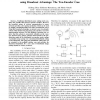Free Online Productivity Tools
i2Speak
i2Symbol
i2OCR
iTex2Img
iWeb2Print
iWeb2Shot
i2Type
iPdf2Split
iPdf2Merge
i2Bopomofo
i2Arabic
i2Style
i2Image
i2PDF
iLatex2Rtf
Sci2ools
CORR
2010
Springer
2010
Springer
Distributed Successive Approximation Coding using Broadcast Advantage: The Two-Encoder Case
Abstract-- Traditional distributed source coding rarely considers the possible link between separate encoders. However, the broadcast nature of wireless communication in sensor networks provides a free gossip mechanism which can be used to simplify encoding/decoding and reduce transmission power. Using this broadcast advantage, we present a new two-encoder scheme which imitates the ping-pong game and has a successive approximation structure. For the quadratic Gaussian case, we prove that this scheme is successively refinable on the {sumrate, distortion pair} surface, which is characterized by the ratedistortion region of the distributed two-encoder source coding. A potential energy saving over conventional distributed coding is also illustrated. This ping-pong distributed coding idea can be extended to the multiple encoder case and provides the theoretical foundation for a new class of distributed image coding method in wireless scenarios.
CORR 2010 | Education | Free Gossip Mechanism | Quadratic Gaussian Case | Traditional Distributed Source |
| Added | 09 Dec 2010 |
| Updated | 09 Dec 2010 |
| Type | Journal |
| Year | 2010 |
| Where | CORR |
| Authors | Zichong Chen, Guillermo Barrenetxea, Martin Vetterli |
Comments (0)

